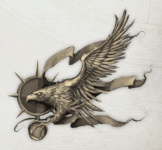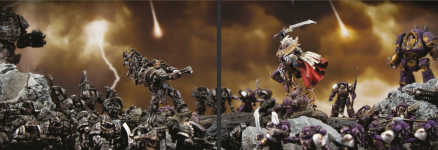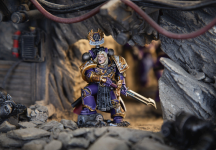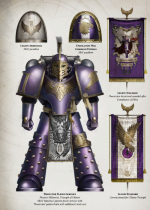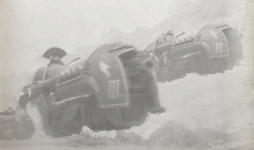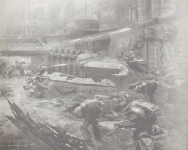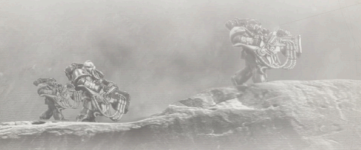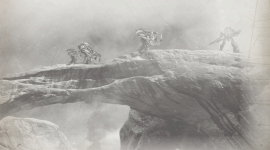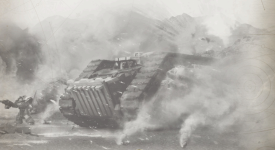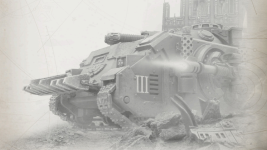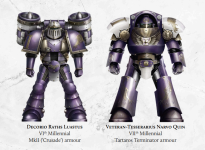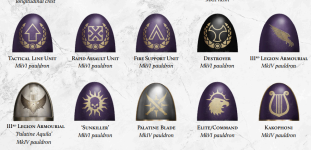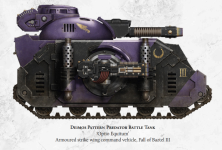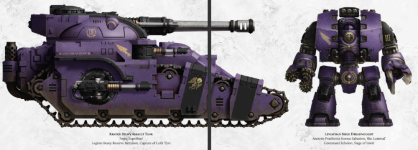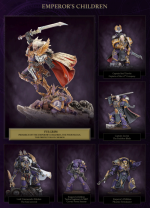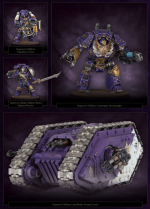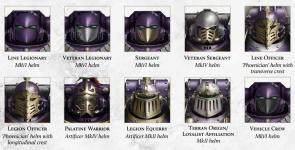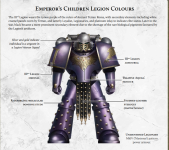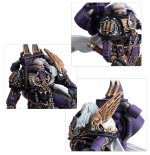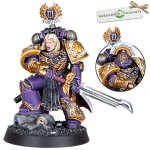Horus Heresy Age of Darkness Rulebook (2022)
Mark IV Maximus Armour-
Intended to be the exemplar of power armour, Maximus Armour provided greater agility to its wearer without sacrificing the durability of Mark II power armour. Mark IV was in mass production at the time the Horus Heresy broke out, and so had been issued to every single Legion. With the benefit of hindsight, however, it is evident that the bulk of Maximus Armour stocks had been diverted to those Legions the Warmaster anticipated would follow him into treachery, the better, it is assumed, to equip them for the rigours of the war he planned to unleash. Of note the Warmaster’s own Legion, the Sons of Horus, made use of great quantities of Mark IV armour, along with the World Eaters, Night Lords and Thousand Sons who might have been ostracised from official supply chains but for Horus’ granted boon. At the outset of the Horus Heresy, Maximus Armour was perhaps the most common pattern in use, though this was short-lived, as even the huge stocks of Mark IV issued to the Traitors in preparation for the war could not withstand the sheer destruction wrought through the long years of the Great Heresy. In time, other marks would come to replace it, particularly as many of its advanced components were incompatible with those of older marks, and as such could not be recycled as part of battlefield repairs or combined into new suits.
Mk IV pattern power armour was especially prevalent in the ranks of the Sons of Horus, who as the Legion of the Warmaster himself were granted priority access when it was first issued. Other Legions that made extensive use of the pattern include the Emperor’s Children, the Night Lords and the Ultramarines.
Mark VI Corvus Armour-
Corvus Armour, which entered service just before the outbreak of the Horus Heresy, was equipped with advanced auto-sensory technology and a more efficient power distribution system than Mark IV. Prototype forms of Mark VI armour were in circulation amongst many Legions during the Great Crusade with varying success; the Iron Warriors famously rejecting the pattern in favour of heavier armour. Many of the first suits which were evacuated from the Martian Schism were issued to the Raven Guard, who favoured them for their lightweight and stealthy profile. The Alpha Legion, too, is believed to have obtained an early schematic for the production of Mark VI armour and used it widely from the onset of the Horus Heresy. By the later stages of the Age of Darkness, Mark VI was in wide use throughout almost every Legion, for both sides were able to call upon Forge Worlds in possession of the imprints to manufacture it. By the time of the Siege of Terra, Mark VI was fast becoming the most numerous pattern in service, seeing significant use among the Imperial Fists and Blood Angels Legions as they prepared for the defence of Terra, and on the Traitor side, it was worn en-masse by the Emperor’s Children during the Siege of Terra. In the closing days of the Siege of Terra, the Loyalists would introduce yet another mark of power armour: Mark VII ‘Aquila Armour’. This variant had its roots in developmental work undertaken in the last few years of the Horus Heresy, and was little more than experimental, even when it entered limited service. In the Great Scouring that followed, it would be Marks VI and VII which would enter mass distribution amongst the Loyalists, but such grim tales are the preserve of another volume.
The Sundered and the Black-
The ‘Shattered Legions’ was a term attributed to abroad range of unconventional or irregular Legiones Astartes formations. The main body of warriors first called the Shattered Legions were born of the fiery crucible of the Isstvan V Dropsite Massacre, where the treachery of the second attack wave resulted in the nigh-total destruction of the Raven Guard, Salamanders and Iron Hands. These three Legions ceased to exist as coherent, operational military bodies, but many survivors escaped the black sands and were forced to drastically adapt their organisation and their methods in order to remain a functional fighting force. In the aftermath of the massacre, bloody, scattered groups from all three Legions coalesced across an entire sector of space, driven by the hunter-killer forces of the Sons of Horus and the Emperor’s Children. Harried by their relentless foe, the last of these remnant forces turned at bay and hit back, and for a time led a fierce-fought guerrilla campaign of vengeance against the Traitors that drew on and combined the unique skills and experience of each element, and which cost the Warmaster’s war effort dearly. But it was not only the remnants of the three Legions that were betrayed at Isstvan V who fought in this manner. Across the entire Imperium and beyond, Legion elements cut off from their chains of command were forced to adapt to circumstances or else perish in the all-consuming fires of war. Some detached Loyalist forces were able to break through the Traitors’ lines and join the mustering hosts of the Imperium. Others, however, found themselves isolated deep within enemy-held territory and too far behind enemy lines to make contact with allied forces. Neither was the formation of these Shattered Legion forces unique to those loyal to Terra. As the civil war progressed, many more found themselves acting alone, following the goals of their own leaders, and at times these goals differed from those of the chains of
Command that had once bound them. With the ebb and flow of war, Traitor forces too became isolated and, given the nature of certain of their leaders, many Traitor units determined to act entirely according to their own drives and desires. Some resurrected ancient resentments against erstwhile brethren now turned to blood-foes, pursuing vengeance for slights of honour thought long forgotten. Others became consumed by the forces they had unleashed upon Isstvan V, shedding reason and honour and reaving across the stars as if to vindicate, or perhaps to forget, their treachery with the blood of all those they branded enemy.
Legion contingents, or even single warriors, entirely denounced their parent Legions or allegiances, and newborn Legionaries were created from gene-stock whose provenance was unknown. Evoking ancient martial traditions, these warriors scratched their Legion emblems or took on new colours and emblems as their own, becoming independent warrior bodies called ‘Blackshields’. Many Blackshields were broken in mind and spirit, driven to madness or despair by the grim realities and responsibilities of this new Age of Darkness. They no longer recognised or acknowledged the mastery of any lord and were determined to claim their own destiny even as the Imperium tore itself apart in bitter civil war. Unlikely alliances would form between Legions, with Traitor elements of the Loyalist Legions and Loyalist elements of the Traitor Legions joining forces with other factions with whom they shared ideologies, ambitions or enemies. Such forces fought throughout this era, sometimes adding their weight to one side or the other, at other times pursuing their own inexplicable goals. Leaders of vision and character melded these disparate Legion elements into highly effective forces and used them to prosecute the unseen shadow wars that raged across the galaxy, often unknown to the masters of either side of the civil war.
Mark IV Maximus Armour-
Intended to be the exemplar of power armour, Maximus Armour provided greater agility to its wearer without sacrificing the durability of Mark II power armour. Mark IV was in mass production at the time the Horus Heresy broke out, and so had been issued to every single Legion. With the benefit of hindsight, however, it is evident that the bulk of Maximus Armour stocks had been diverted to those Legions the Warmaster anticipated would follow him into treachery, the better, it is assumed, to equip them for the rigours of the war he planned to unleash. Of note the Warmaster’s own Legion, the Sons of Horus, made use of great quantities of Mark IV armour, along with the World Eaters, Night Lords and Thousand Sons who might have been ostracised from official supply chains but for Horus’ granted boon. At the outset of the Horus Heresy, Maximus Armour was perhaps the most common pattern in use, though this was short-lived, as even the huge stocks of Mark IV issued to the Traitors in preparation for the war could not withstand the sheer destruction wrought through the long years of the Great Heresy. In time, other marks would come to replace it, particularly as many of its advanced components were incompatible with those of older marks, and as such could not be recycled as part of battlefield repairs or combined into new suits.
Mk IV pattern power armour was especially prevalent in the ranks of the Sons of Horus, who as the Legion of the Warmaster himself were granted priority access when it was first issued. Other Legions that made extensive use of the pattern include the Emperor’s Children, the Night Lords and the Ultramarines.
Mark VI Corvus Armour-
Corvus Armour, which entered service just before the outbreak of the Horus Heresy, was equipped with advanced auto-sensory technology and a more efficient power distribution system than Mark IV. Prototype forms of Mark VI armour were in circulation amongst many Legions during the Great Crusade with varying success; the Iron Warriors famously rejecting the pattern in favour of heavier armour. Many of the first suits which were evacuated from the Martian Schism were issued to the Raven Guard, who favoured them for their lightweight and stealthy profile. The Alpha Legion, too, is believed to have obtained an early schematic for the production of Mark VI armour and used it widely from the onset of the Horus Heresy. By the later stages of the Age of Darkness, Mark VI was in wide use throughout almost every Legion, for both sides were able to call upon Forge Worlds in possession of the imprints to manufacture it. By the time of the Siege of Terra, Mark VI was fast becoming the most numerous pattern in service, seeing significant use among the Imperial Fists and Blood Angels Legions as they prepared for the defence of Terra, and on the Traitor side, it was worn en-masse by the Emperor’s Children during the Siege of Terra. In the closing days of the Siege of Terra, the Loyalists would introduce yet another mark of power armour: Mark VII ‘Aquila Armour’. This variant had its roots in developmental work undertaken in the last few years of the Horus Heresy, and was little more than experimental, even when it entered limited service. In the Great Scouring that followed, it would be Marks VI and VII which would enter mass distribution amongst the Loyalists, but such grim tales are the preserve of another volume.
‘All I wish to hear from your imperfect world is the silence of its dead.’
-Lord Commander Lothreal Sabine of the Emperor’s Children, Communiqué to the Judicator of Nalislarr
The Sundered and the Black-
The ‘Shattered Legions’ was a term attributed to abroad range of unconventional or irregular Legiones Astartes formations. The main body of warriors first called the Shattered Legions were born of the fiery crucible of the Isstvan V Dropsite Massacre, where the treachery of the second attack wave resulted in the nigh-total destruction of the Raven Guard, Salamanders and Iron Hands. These three Legions ceased to exist as coherent, operational military bodies, but many survivors escaped the black sands and were forced to drastically adapt their organisation and their methods in order to remain a functional fighting force. In the aftermath of the massacre, bloody, scattered groups from all three Legions coalesced across an entire sector of space, driven by the hunter-killer forces of the Sons of Horus and the Emperor’s Children. Harried by their relentless foe, the last of these remnant forces turned at bay and hit back, and for a time led a fierce-fought guerrilla campaign of vengeance against the Traitors that drew on and combined the unique skills and experience of each element, and which cost the Warmaster’s war effort dearly. But it was not only the remnants of the three Legions that were betrayed at Isstvan V who fought in this manner. Across the entire Imperium and beyond, Legion elements cut off from their chains of command were forced to adapt to circumstances or else perish in the all-consuming fires of war. Some detached Loyalist forces were able to break through the Traitors’ lines and join the mustering hosts of the Imperium. Others, however, found themselves isolated deep within enemy-held territory and too far behind enemy lines to make contact with allied forces. Neither was the formation of these Shattered Legion forces unique to those loyal to Terra. As the civil war progressed, many more found themselves acting alone, following the goals of their own leaders, and at times these goals differed from those of the chains of
Command that had once bound them. With the ebb and flow of war, Traitor forces too became isolated and, given the nature of certain of their leaders, many Traitor units determined to act entirely according to their own drives and desires. Some resurrected ancient resentments against erstwhile brethren now turned to blood-foes, pursuing vengeance for slights of honour thought long forgotten. Others became consumed by the forces they had unleashed upon Isstvan V, shedding reason and honour and reaving across the stars as if to vindicate, or perhaps to forget, their treachery with the blood of all those they branded enemy.
Legion contingents, or even single warriors, entirely denounced their parent Legions or allegiances, and newborn Legionaries were created from gene-stock whose provenance was unknown. Evoking ancient martial traditions, these warriors scratched their Legion emblems or took on new colours and emblems as their own, becoming independent warrior bodies called ‘Blackshields’. Many Blackshields were broken in mind and spirit, driven to madness or despair by the grim realities and responsibilities of this new Age of Darkness. They no longer recognised or acknowledged the mastery of any lord and were determined to claim their own destiny even as the Imperium tore itself apart in bitter civil war. Unlikely alliances would form between Legions, with Traitor elements of the Loyalist Legions and Loyalist elements of the Traitor Legions joining forces with other factions with whom they shared ideologies, ambitions or enemies. Such forces fought throughout this era, sometimes adding their weight to one side or the other, at other times pursuing their own inexplicable goals. Leaders of vision and character melded these disparate Legion elements into highly effective forces and used them to prosecute the unseen shadow wars that raged across the galaxy, often unknown to the masters of either side of the civil war.
Last edited:



